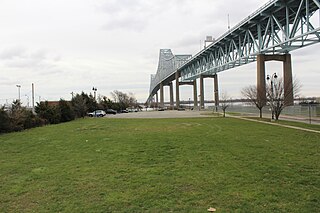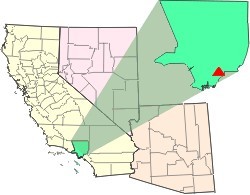Related Research Articles

Munisport Landfill is a closed landfill located in North Miami, Florida adjacent to a low-income community, a regional campus of Florida International University, Oleta River State Park, and estuarine Biscayne Bay.
The Edison Wetlands Association was founded by noted activist Robert Spiegel in 1989 as a nonprofit environmental organization devoted to the cleanup of hazardous waste sites and the preservation of open space in densely populated central New Jersey.

Havertown Superfund is a 13-acre polluted groundwater site in Havertown, Pennsylvania contaminated by the dumping of industrial waste by National Wood Preservers from 1947 to 1991. The state first became aware of the pollution in 1962 and initiated legal action against the owners in 1973 to force them to cleanup the site. The Environmental Protection Agency (EPA) ranked the site the eighth worst cleanup project in the United States. The site was added to the National Priorities List in 1983 and designated as a Superfund cleanup site in early 1990s. Remediation and monitoring efforts are ongoing and the EPA transferred control of the site to the Pennsylvania Department of Environmental Protection in 2013.
An injection well is a device that places fluid deep underground into porous rock formations, such as sandstone or limestone, or into or below the shallow soil layer. The fluid may be water, wastewater, brine, or water mixed with industrial chemical waste.
The Lipari Landill is an inactive landfill on a 6-acre (2.4 ha) former gravel pit in Mantua Township, New Jersey, United States, that was used from 1958 to 1971 as a dump site for household and industrial wastes. Toxic organic compounds and heavy metals dumped at the site have percolated into the ground water and leached into lakes and streams in the surrounding area. The site has been identified as the worst toxic dump in the United States and was ranked at the top of the United States Environmental Protection Agency's Superfund eligibility list.

Wade Dump was a rubber recycling facility and illegal industrial waste storage and disposal facility in Chester, Pennsylvania. It was located at 1 Flower Street on the western bank of the Delaware River just north of the Commodore Barry Bridge. A toxic fire at the site in 1978 burned out of control for several days and resulted in 43 injured firefighters and criminal charges for the owner of the site. The first responders to the fire suffered long term health consequences and higher than normal cancer rates.
Imperial Oil is a current Superfund site located off Orchard Place near Route 79 in Morganville, Marlboro Township, Monmouth County, New Jersey. This site is one of 114 Superfund sites in New Jersey. It is in the U.S. Environmental Protection Agency (EPA) Region 2 Superfund area of control and organization. The 15-acre (61,000 m2) Imperial Oil Co./Champion Chemicals site consisted of six production, storage, and maintenance buildings and 56 above-ground storage tanks.
The Del Amo Superfund Site is a U.S. EPA Region 9 Superfund Site. It is one of 94 Superfund Sites in California as of November 29, 2010.
The Oakdale Dump is an Environmental Protection Agency Superfund site located in Oakdale, Minnesota, and comprises three non-contiguous properties that were used for dumping from the late 1940s until the 1950s by the 3M corporation. The properties are named the Abresch, Brockman, and Eberle sites for their respective property owners at the time of disposal activities. The Abresch site is the largest of the three properties at about 55 acres. The Brockman site is located immediately southwest of the Abresch site and encompasses 5 acres. The Eberle site is located roughly 2,500 feet north of the Abresch site and encompasses 2 acres.

Halaco Engineering Co. operated a scrap metal recycling facility at 6200 Perkins Road, Oxnard, Ventura County, California from 1965 to 2004. The state placed the facility on the California Hazardous Waste Priority List in 2007. The facility includes a smelter area west and the Waste Management Unit (WMU) east of the Oxnard Industrial Drain (OID). Attention was brought to the Halaco site through illegal waste disposal without permits. Further investigation yielded a discovery of harmful contaminants. Remediation of surrounding contaminated areas including the wetlands was completed in 2007. Restoration of the wetlands and management of the WMU are ongoing.

The Waste Disposal Inc. Superfund site is an oil-related contaminated site in the highly industrialized city of Santa Fe Springs in Los Angeles County, California. It is approximately 38 acres (15 ha), with St Paul's high school immediately adjacent to the northeast corner of the site. Approximately 15,000 residents of Santa Fe Springs obtain drinking water from wells within three miles (4.8 km) of the site.

Groundwater pollution occurs when pollutants are released to the ground and make their way down into groundwater. This type of water pollution can also occur naturally due to the presence of a minor and unwanted constituent, contaminant or impurity in the groundwater, in which case it is more likely referred to as contamination rather than pollution.
Kauffman & Minteer Inc. (K&M) was an industrial transportation company that operated from 1960 to 1981 in Burlington County, New Jersey. After cleaning their trucks, they dumped the waste water into a nearby lagoon that was not properly lined. The lagoon flooded and the waste water containing chemicals, migrated over to wetlands, causing damage to vegetation and seeping into underground drinking water. The Environmental Protection Agency (EPA) got involved in 1989 and conducted a few remediation attempts but the extent of the damage is hard to determine as the different underground pathways of water are unpredictable. The site is currently an active superfund site that is closely monitored by the EPA.
Emmell's Septic Landfill (ESL) is located at 128 Zurich Ave, Galloway Township, New Jersey and takes up about 38 acres of space. The landfill was in operation from 1967 until 1979. ESL disposed of liquid and solid waste including many chemicals such as volatile organic compounds (VOCs), Polychlorinated Biphenyls (PCBs), Trichloroethene and Vinyl chloride which all had their own effect on the environment and community. These chemicals affected the groundwater required millions of dollars to reconstruct the groundwater pathways and provide clean water to residents. The landfill holds a Hazardous Ranking Score of a 50/100, qualifying for the Superfund National Priority List. In August 1999, the state acknowledged the site's contamination and held town meetings and provided research upon the site such as groundwater samples. In July 1997, a sitewide investigation was called upon by the United States Environmental Protection Agency. In total the clean up was estimated to cost $5 million to fund this superfund site, and a grant of $3.9 million was given by the Federal Government under the Recovery Act Funding (Previti). Today, the project is still ongoing however, greatly improved since the landfill was discovered.
Bog Creek Farm, located in Howell Township, New Jersey, is a designated Environmental Protection Agency (EPA) Superfund site. Laying on 12 acres of land, Bog Creek Farm is home to several hazardous and life-threatening contamination beginning in 1973 and continuing for a year. Over a decade later, actions began to take place to clean and restore the contaminated soil and water. Bog Creek Farm is situated near several other farms that house horses, growing crops and flowers, and livestock. Less than a mile down the road lies Allaire State Park, a park used by golfers, hunters, and fisherman.
Brook Industrial Park (BIP) is an industrial area occupying 4.5 acres of the Borough of Bound Brook, New Jersey, in the United States of America. It is located on the northern bank of the Raritan River. Industrial, chemical and pesticide operations began in 1971 and eventually lead to the contamination of groundwater and exposure of workers to harmful dioxins. Throughout 1980 to 1988 the United States Environmental Protection Agency (EPA) and the New Jersey Department of Environmental Protection (NJDEP) conducted studies to determine if there were any threats being posed on the workers, community or environment by the BIP companies in their disposal of processed and stored chemicals.
The Zschiegner Refining Company (ZRC) was located in Howell, New Jersey, and operated as a metal refining facility. Some of their operations included stripping the chemicals off of precious metals from watch bands, photographic film, and electrical components. In 1992, the United States Environmental Protection Agency (EPA) discovered that 3,000 chemicals had contaminated the soil, surface water, and groundwater. These areas were contaminated due to discharge of waste to the ground surface, the movement of waste and contamination downhill from the site building, along with surface water runoff. When the EPA investigated the site and found the chemicals in the groundwater and soil, they shut down the company that same year in 1992. In that area, the environment and people were affected, especially the workers in the facility. After a Hazard Ranking System report was conducted by the EPA, the site was placed on the National Priorities List in March 1998. In 2008, the cleanup was completed, but groundwater and wetland is still being monitored.
Price Landfill is a 26-acre site located in Pleasantville, Egg Harbor Township, Atlantic County, New Jersey. Price Landfill is also known as Price Sanitary Landfill, Prices Pit, Price Landfill No.1 and Price Chemical Dump. The United States Environmental Protection Agency (USEPA) added Price Landfill to the Superfund National Priorities List on September 20, 1983 because of the hazardous chemicals found on the site and in the groundwater. The site was originally owned by Mr. Charles Price and was used to mine sand and gravel, which was shut down in 1968. The site was then turned into a private landfill in 1969 and then a commercial solid waste landfill in 1971. At this point the landfill was used to dispose of liquid waste by companies, specifically Atlantic City Electric Company. The liquid waste consisted of industrial chemicals, oils and greases/sludges, septic tank and sewer wastes, which were disposed on the site for 8 years, ending altogether in 1976, but in the meantime, having contaminated the groundwater, soil, air, and nearby creeks, specifically Absecon Creek. Chemicals dumped on the site are believed to be 1,2-Dichloroethane, arsenic, benzene, chloroform, lead, and vinyl chloride, all of which contaminated the groundwater, soil, air, and nearby creeks. The USEPA originally got involved in 1982 by beginning to correct the damage. Currently the USEPA states that they are continuing to monitor and treat the groundwater and land, and that hazards to humans are controlled.
The Burnt Fly Bog Superfund Site is located in Marlboro Township in Monmouth County, New Jersey. Contamination began in the 1950s and 1960s. It was used as a dumping ground for hazardous chemicals and oils. This site was used to reprocess or recycle oil, and it was also used as a landfill during the 1950s. The contamination affected the surface water and soil. The EPA got involved in the 1980s and addressed the situation. Human health concerns were a main part of the EPA getting involved because residents lived only about 1,000 to 2,000 feet around the site. Major components of the remedy included excavation and off-site disposal of contaminated soil from Northerly Wetlands, Tar Patch Area. The back filling of the areas addressed, monitoring of the surface water and sediments, and biological sampling in the Westerly Wetlands. The current status of the site is complete. The remedial stages were completed in the late 1990s and a five-year monitoring of the surface water was completed around 2004.

The G&H Industrial Landfill is a Superfund site located in Shelby Charter Township near Utica, Michigan. The 60-acre (24-hectare) landfill, with about 10 to 20 acres of adjacent property, operated as a waste oil recovery facility from 1955 to 1967. From 1955 to 1974 the site was used as an industrial and municipal landfill. Contaminated soil, surface water, and groundwater with hazardous chemicals have been left behind as a result of the disposal of waste solvents, waste oil and paint sludge. Operation and maintenance activities are ongoing following the cleanup.